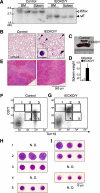Loss of the Gata1 gene IE exon leads to variant transcript expression and the production of a GATA1 protein lacking the N-terminal domain
- PMID: 19854837
- PMCID: PMC2804226
- DOI: 10.1074/jbc.M109.030726
Loss of the Gata1 gene IE exon leads to variant transcript expression and the production of a GATA1 protein lacking the N-terminal domain
Abstract
GATA1 is essential for the differentiation of erythroid cells and megakaryocytes. The Gata1 gene is composed of multiple untranslated first exons and five common coding exons. The erythroid first exon (IE exon) is important for Gata1 gene expression in hematopoietic lineages. Because previous IE exon knockdown analyses resulted in embryonic lethality, less is understood about the contribution of the IE exon to adult hematopoiesis. Here, we achieved specific deletion of the floxed IE exon in adulthood using an inducible Cre expression system. In this conditional knock-out mouse line, the Gata1 mRNA level was significantly down-regulated in the megakaryocyte lineage, resulting in thrombocytopenia with a marked proliferation of megakaryocytes. By contrast, in the erythroid lineage, Gata1 mRNA was expressed abundantly utilizing alternative first exons. Especially, the IEb/c and newly identified IEd exons were transcribed at a level comparable with that of the IE exon in control mice. Surprisingly, in the IE-null mouse, these transcripts failed to produce full-length GATA1 protein, but instead yielded GATA1 lacking the N-terminal domain inefficiently. With low level expression of the short form of GATA1, IE-null mice showed severe anemia with skewed erythroid maturation. Notably, the hematological phenotypes of adult IE-null mice substantially differ from those observed in mice harboring conditional ablation of the entire Gata1 gene. The present study demonstrates that the IE exon is instrumental to adult erythropoiesis by regulating the proper level of transcription and selecting the correct transcription start site of the Gata1 gene.
Figures






References
Publication types
MeSH terms
Substances
LinkOut - more resources
Full Text Sources
Molecular Biology Databases

